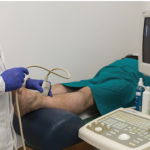
Image Credit: Kritchanut/shutterstock.com
Sternoclavicular joint involvement has rarely been reported in the context of active rheumatoid arthritis (RA).1 Traditionally, rheumatologists use serial radiographs of hands and feet to diagnose, monitor for progression or evaluate the response to treatment. The sternoclavicular (SC) joint is not a typical joint assessed for RA. However, the fact that it is a diarthrodial synovial joint suggests that this joint may be vulnerable to inflammatory process and could potentially be used radiographically to monitor disease progression.
It is well documented that the SC joint can be affected by traumatic or non-traumatic processes, such as infections (septic arthritis, osteomyelitis, tuberculosis),2–5 osteoarthritis,6 inflammatory arthritides,1,7–11 neoplasms12 and hyperparathyroidism.13
In this article, we describe a patient with long-term, poorly controlled RA who presented at our hospital with complaints of chest pain that were due to SC joint arthritis.
Case Presentation
A 52-year-old African American male with a 14-year history of seropositive (anti-CCP antibody and rheumatoid factor positive), erosive RA presented at the hospital with chest pain. He described his pain as dull, constant and located in his right upper chest, without radiation. An acute cardiovascular event was ruled out on the basis of a normal ECG and cardiac enzymes. A computerized tomogram (CT) of the chest revealed severe erosions in the right SC joint (see Figures 1A and 1B). A comparison with another chest CT obtained during the first year following his diagnosis of RA (nine years prior to this presentation) confirmed that the erosions in the SC joint were new.
The SC joint is easily accessible & can be evaluated by ultrasound, CT or magnetic resonance.
During the first five years of his RA diagnosis, the patient was treated with methotrexate, with a gradual increase in the dose up to 25 mg subcutaneous weekly. His response to treatment remained suboptimal, and the calculated disease activity score, based on a 28-joint count (DAS28/ESR), was as high as 4.5. During the subsequent three years, abatacept infusions were added (dose 750 mg monthly). Initially, the patient noted significant improvement in his symptoms, and the disease activity score improved to 2.5.
In the year prior to presentation, the patient started to complain of prolonged morning stiffness and arthralgias, and his physical exam revealed evidence of synovitis in multiple joints (i.e., bilateral metacarpophalangeal, wrists, right elbow, left knee, left ankle, bilateral metatarsophalangeal). Reassessment of his disease activity revealed a DAS28/ESR score of 5.4. X-rays of his hands documented progression of previous erosions and new erosions at the level of bilateral PIP, MCP joints and the ulnar styloid.


